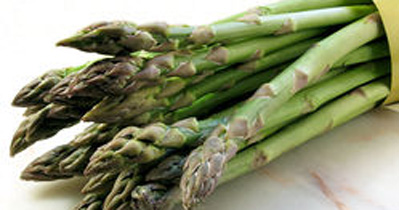Plant asparagus roots or crowns in late winter/early spring (January-February in Central Texas). Prepare beds with heavy amounts of compost and organic fertilizer. We recommend using a mycorrhizal root inoculant (Happy Frog JumpStart contains both fertilizer and microorganisms, as does MicroLife 6-2-4) at the time of planting, as this has been shown to greatly increase yields in asparagus. Be sure to plant in full sun (at least 8 hours) and make sure that the soil drains well.

Because once asparagus gets started it becomes very well established and difficult to eradicate, you should plant asparagus in a permanent location-so plan carefully! Beds should be about 3’ wide, in rows that are at least 4’ apart. Dig a trench 8 inches deep and wide enough to accommodate the outspread roots (about 10 inches), then space the asparagus 18 inches apart. Cover the roots with two inches of soil/compost/fertilizer mix, and continue to fill in the trench as shoots grow. Be careful to not bury the green shoots completely. The trench can usually be filled by the end of the first growing season, but if not, simply continue to work on it the second year.
Do not harvest any shoots for the first two years. The plants use the carbohydrates produced in the leaves to build roots and more shoots, and leaving them alone will ensure a larger harvest in the future. During the third growing season, harvest all tender green shoots, breaking off spears when 6” to 8” tall at ground level as they emerge in early summer. You should be able to harvest over a 3-4 week period this year, and over a 6-8 week period in subsequent years. Harvesting shoots at this time encourages the plant to produce more green shoots, so try to harvest as many as you can. After harvest is over, let shoots mature to fern-like growth to allow regeneration of energy for next year’s crop. The first two years, work compost and organic fertilizer into the soil in the spring, and again after harvest. Do not overwater asparagus as this may cause crown rot and loss of new or established plantings. After the tops have frozen back in the late fall or winter, remove them promptly. If there is no freeze by late fall-early winter, cut the yellowed tops back to the ground with a sharp knife or pruners. Use a hoe to mound soil over the crowns to prevent cold damage and to insulate against unseasonably warm winters.
From the third year on, rather than fertilize the spears before they emerge, apply the fertilizer about two weeks before the end of harvest, using the same Micro Life 6-2-4 with beneficial microorganisms as you did before.
Asparagus have few insect or disease problems. If Asparagus beetles show up, simply pick them off by hand and drop them into a bucket of soapy water. Keep weeds at bay by mulching generously after harvest to prevent weed growth during the summer months. Asparagus beds should receive at least 1” of water weekly during the growing season. Winter watering is necessary only if we do not receive an inch of rain in a two week period.
With good cultural care, you should be able to harvest 8-12 spears from each asparagus crown each year.




